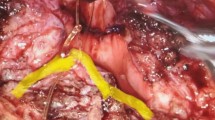Abstract
Robotic radical prostatectomy (RARP) is well established as a safe and effective treatment for prostate cancer. According to published studies, patients undergoing RARP are at increased risk of being diagnosed with an inguinal hernia after RARP and are four times more likely to have an inguinal hernia repair (IHR) following RARP. Several studies have demonstrated the effectiveness and safety of IHR during RARP. Overall, it has been observed that IHR adds on average, 12–15 min in total surgical time and there were no significant differences between RARP with or without IHR with respect to postoperative complications. This study analyzes a large series of patients undergoing RARP (1100) and compares them to a group that underwent RARP with IHR (39). Between December 2008 and January 2015, 1139 patients underwent RARP at Florida Hospital in Celebration, FL. Of the total patients, 39 underwent concomitant IHR. All procedures were performed by the same surgeons (urologist and general surgeon), using the same techniques of RARP and TAPP inguinal hernia repair. After 30 days, the differences were evaluated between groups regarding surgical time, EBL and postoperative complications. The average age of patients undergoing the procedure was 61.65 years. The mean procedure time was approximately 120 min (min), with an additional period of 68 min for IHR (mean = 188; p = 0.0001). There was a significant difference in BMI between the groups, 28.3 kg/m2 for patients undergoing RARP and 26.8 kg/m2 for those who underwent RARP and IHR (p = 0.028). The EBL averaged 110.87 mL, with no significant difference between groups (p = 0371). There was no significant association between clinical stage of the patient and the type of procedure performed (p = 12:35). There was no significant difference in the presence of comorbidities and the operation preformed. There were 61 events recorded postoperatively, 57 (5.2%) among patients who underwent only RARP and 4 (10.26%) among those who had both. Taken together, the small amounts of complications in both groups prevent statistical significance. This study compared two groups of patients undergoing RARP: those with IHR and those without. Our study demonstrated an increase in surgical time; however, there was no increase in postoperative complications. From the data presented, we suggest that the performance of both procedures concomitantly is feasible and safe.
Similar content being viewed by others
References
Novara G, Ficarra V, Mocellin S, Ahlering TE, Carroll PR, Graefen M et al (2012) Systematic review and meta-analysis of studies reporting oncologic outcome after robot-assisted radical prostatectomy. Eur Urol 62(3):382–404
Ficarra V, Novara G, Rosen RC, Artibani W, Carroll PR, Costello A et al (2012) Systematic review and meta-analysis of studies reporting urinary continence recovery after robot-assisted radical prostatectomy. Eur Urol 62(3):405–417
Novara G, Ficarra V, Rosen RC, Artibani W, Costello A, Eastham JA et al (2012) Systematic review and meta-analysis of perioperative outcomes and complications after robot-assisted radical prostatectomy. Eur Urol 62(3):431–452
Qazi H, Rai B, Do M, Rewhorn M, Häfner T (2015) Robot-assisted laparoscopic total extraperitoneal hernia repair during prostatectomy: technique and initial experience. Cent Eur J Urol 68(2):240–244
Sun M, Lughezzani G, Alasker A, Isbarn H, Jeldres C, Shariat SF, Budäus L, Lattouf JB, Valiquette L, Graefen M, Montorsi F, Perrote P, Karakiewicz PI (2010) Comparative study of inguinal hernia repair after radical prostatectomy, prostate biopsy, transurethral resection of the prostate or pelvic lymph node dissection. J Urol 183(3):970–975
Stranne J, Hugosson J, Lodding P (2006) Post-radical retropubic prostatectomy inguinal hernia: an analysis of risk factors with special reference to preoperative inguinal hernia morbidity and pelvic lymph node dissection. J Urol 176(5):2072–2076
Nilsson H, Stranne J, Stattin P, Nordin P (2014) Incidence of groin hernia repair after radical prostatectomy: a population-based nationwide study. Ann Surg 259(6):1223–1227
Abe T, Shinohara N, Harabayashi T, Sazawa A, Suzuki S, Kawarada Y et al (2007) Postoperative inguinal hernia after radical prostatectomy for prostate cancer. Urology 69(2):326–329
Finley D, Savatta D, Rodriguez E, Kopelan A (2008) Transperitoneal robotic-assisted laparoscopic radical prostatectomy and inguinal herniorrhaphy. J Robot Surg 1(4):269–272
Joshi A, Spivak J, Rubach E (2010) Concurrent robotic trans-abdominal pre-peritoneal (TAP) herniorrhaphy during robotic-assisted radical prostatectomy. Int J Med Robot 6(3):311–314
Nakamura L, Nunez R, Castle E (2011) Different approaches to an inguinal hernia repair during a simultaneous robot-assisted radical prostatectomy. J Endourol 25(4):621–624
Rabbani F, Herran L, Touijer K, Brady MS (2011) Predictors of inguinal hernia after radical prostatectomy. Urology 77:391–395
Regan TC, Mordkin RM, Constantinople NL, Spence IJ, Dejter SW (1996) Incidence of inguinal hernias following radical retropubic prostatectomy. Urology 47(4):536–537
Celik O, Akand M, Ekin G, Duman I, Ilbey YO, Erdogru T (2015) Laparoscopic radical prostatectomy alone or with laparoscopic herniorrhaphy. J Soc Laparoendosc Surg 19(4):e2015.00090
Lee DK, Montgomery DP, Porter JR (2013) Conturrent transperitoneal repair for incidentally detected inguinal hernias during robotically assisted radical prostatectomy. Urology 82(6):1320–1322
Mourmouris P, Argun OB, Tufek I, Obek C, Skolarikos A, Tuna MB, Keskin S, Kural AR (2016) Nonprostetic direct inguinal hernia repair during robotic radical prostatectomy. J Endourol 30(2):218–222
Author information
Authors and Affiliations
Corresponding author
Ethics declarations
Conflict of interest
The authors Travis Rogers, Eduardo Parra-Davila, Flavio Malcher, Carlos Hartmann, Bernardo Mastella, Guiherme de Araújo, Gabriel Ogaya-Pinies, Carlos Ortiz-Ortiz, Eduardo Hernandez-Cardona, Vipul Patel, and Leandro Totti Cavazzola declare that they have no conflicts of interest.
Ethical approval
All procedures performed in studies involving human participants were in accordance with the ethical standards of the institutional and/or national research committee and with the 1964 Helsinki Declaration and its later amendments or comparable ethical standards.
Rights and permissions
About this article
Cite this article
Rogers, T., Parra-Davila, E., Malcher, F. et al. Robotic radical prostatectomy with concomitant repair of inguinal hernia: is it safe?. J Robotic Surg 12, 325–330 (2018). https://doi.org/10.1007/s11701-017-0737-6
Received:
Accepted:
Published:
Issue Date:
DOI: https://doi.org/10.1007/s11701-017-0737-6




